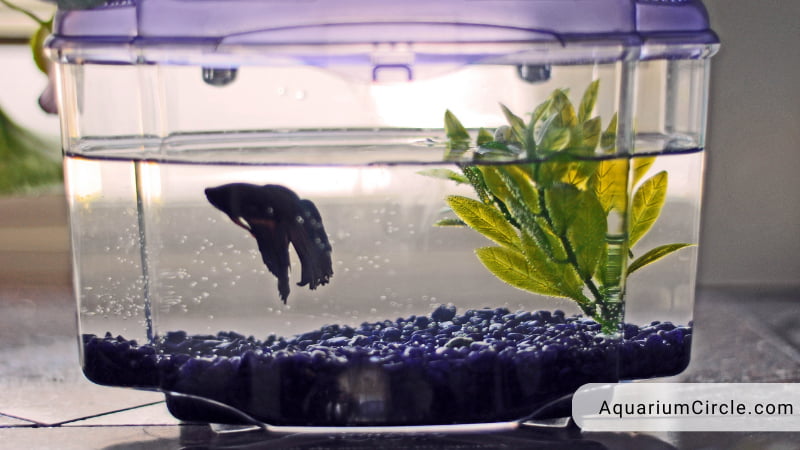Betta fish are beautiful creatures; with their vibrant colors and magnificent fins, they deserve a home where they can live and live a healthy life.
In this post, we will together walk through a detailed three-step process of Betta fish tank setup to help you set up a betta fish tank and how to maintain their ideal environment.
See also:
- Betta Fish Water Temperature: What Is The Ideal Range Of Betta Fish Water Temp?
- Betta Fish Toys – 17 Best Betta Fish Toys For A Joyful Life
- Betta Fish Natural Habitat: Where Do Betta Fish Come From And How Do They Live In Wild Environment?
Let’s get this ball rolling.
Betta Fish Tank Setup Step 1: Picking Suitable Betta Fish Tank And Accessories
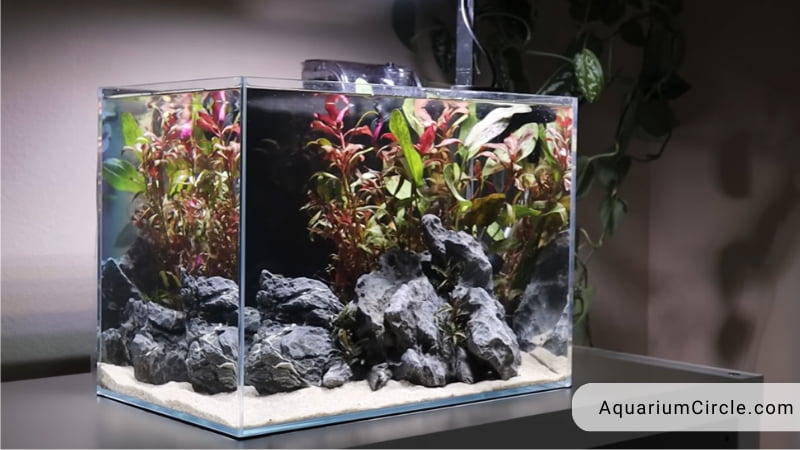
When selecting your Betta fish, it is crucial to take into account some initial factors. This part covers all the key aspects to consider when choosing your Betta fish tank and accessories.
Tank size recommendations
One of the essential aspects of setting up a Betta fish tank is choosing the appropriate size. Betta fish are often sold in small cups or bowls, but these are not suitable habitats for them. Keeping your Betta fish in a small container can result in stress, stunted growth, and decreased lifespan.
A minimum tank size of 5 gallons is recommended for a single Betta fish. However, larger tanks are always better as they provide more swimming space, room for plants and decorations, and easier maintenance. A tank size of 10-20 gallons is ideal for a Betta fish and allows for the addition of tank mates if desired.
It’s also important to consider the shape of the tank when choosing the size. Long and shallow tanks are preferable over tall and narrow ones since Betta fish are surface dwellers and require access to the surface for oxygen.
Tank material options
When it comes to Betta fish tank materials and options, there are a few choices to consider. The most common options include glass and acrylic tanks, as well as plastic containers.
Glass tanks are the most popular and widely available option. They are sturdy, easy to clean, and provide clear viewing of the fish. However, they can be heavy and breakable, so extra care is needed when moving or cleaning them.
Acrylic tanks are a lighter and more durable alternative to glass tanks. They are less likely to break, scratch-resistant, and offer better insulation, which can help maintain a consistent temperature. However, they are more expensive than glass tanks and can be more challenging to clean.
Plastic containers, such as storage bins, can also be used as Betta fish tanks. They are lightweight, easy to clean, and come in a variety of sizes. However, they are not as aesthetically pleasing as glass or acrylic tanks and may not be as sturdy.
When choosing a Betta fish tank material, consider your preferences and budget, as well as the safety and well-being of your fish. It’s essential to choose a tank that is leak-proof, sturdy, and easy to clean. Avoid using containers that are made of toxic materials, such as those that are not explicitly labeled as safe for fish.
Do Betta fish require filters?
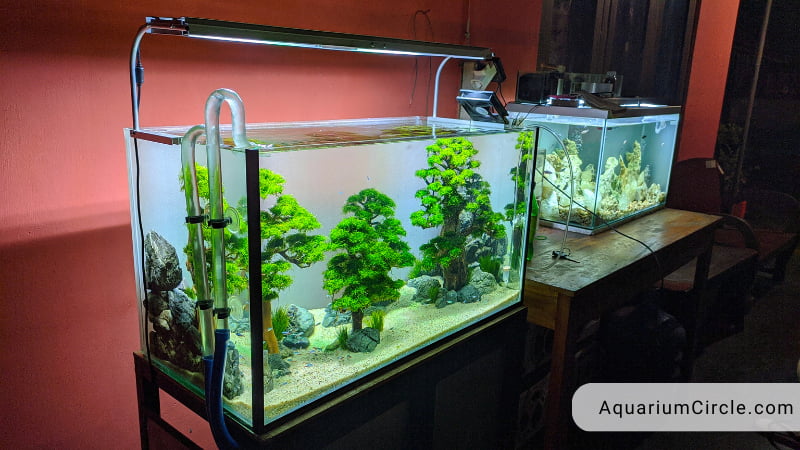
Yes, Betta fish require filters in their tank. Filters are crucial to maintaining water quality and keeping the tank clean. Betta fish produce waste, which can accumulate in the water and harm the fish if not removed. Filters help remove excess waste, debris, and toxins from the water, ensuring a healthy and stable environment for the fish to live in.
It’s important to choose the right filter for your Betta fish tank, as some filters can be too strong and create too much water flow, which can stress the fish. A sponge filter or a gentle flow filter is recommended for Betta fish tanks. It’s also essential to regularly clean and maintain the filter to ensure it functions correctly and efficiently.
Do Betta fish require a heater?
Yes, Betta fish also require a heater in their tank to maintain a consistent temperature. Bettas are tropical fish that come from warm waters and require a water temperature of 76-82°F (24-28°C) to stay healthy and thrive. A heater is necessary to keep the water temperature within this range, as room temperatures can fluctuate and affect the water temperature.
When choosing a heater for your Betta fish tank, it’s essential to choose the right size and wattage based on the tank size. It’s also important to monitor the temperature regularly and ensure it remains within the recommended range.
Obtaining your gravel
Gravel is not a requirement for a Betta fish tank, but it can provide some benefits. Gravel can help anchor plants in the tank, provide a substrate for beneficial bacteria, and create a natural look. It also helps prevent the bottom of the tank from becoming too dirty by trapping debris and waste.
However, if you choose to use gravel in your Betta fish tank, it’s essential to choose a suitable size and type. Large gravel can trap waste and create dead spots, while small gravel can be ingested by the fish and cause health issues. It’s also important to thoroughly clean the gravel before adding it to the tank to remove any debris or dust.
If you decide not to use gravel in your Betta fish tank, a bare bottom or a thin layer of sand can be used as an alternative. These options are easier to clean and maintain than gravel.
Decorations and plants for your Betta
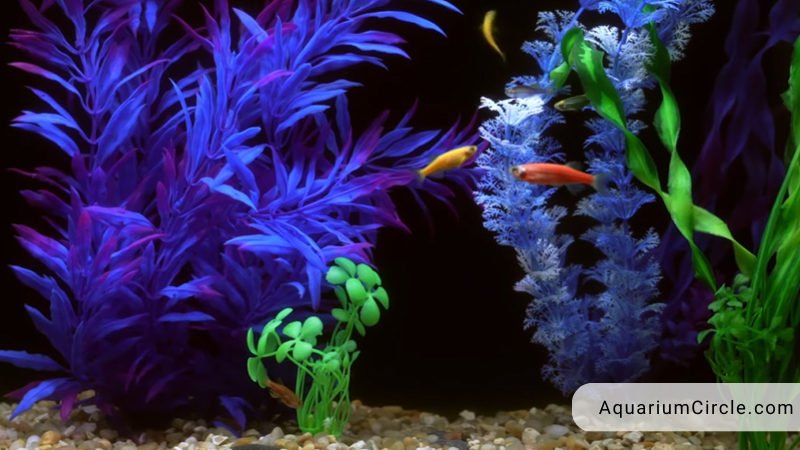
Adding plants and decorations to your Betta fish tank not only enhances its aesthetic appeal but also provides numerous benefits for your fish’s health and well-being. Bettas enjoy hiding, lounging on leaves, and sleeping in secluded areas, so adding decorations and plants can fulfill these needs.
It’s advisable to rearrange the tank’s decorations periodically, such as during water changes or tank cleanings. This helps to prevent your Betta fish from getting bored or depressed due to a lack of stimulation. Keeping your Betta fish interested and engaged in its surroundings can significantly improve its happiness and quality of life.
When selecting decorations and plants for your Betta fish tank, ensure that they are safe for your fish’s delicate fins. Plastic plants can be harmful to Bettas, so it’s better to opt for silk plants or live plants. Live plants are especially beneficial as they replicate your fish’s natural habitat, help clear the water, and provide oxygen to the tank.
See also: Betta Fish Plants: 17 Best Plants For Betta Fish
Lighting for Bettas
Proper lighting is essential for Betta fish, similar to how it is for humans. If your fish tank does not come with lighting, it is crucial to get one to ensure your fish’s health and comfort.
It’s important to establish a consistent lighting schedule for your Betta fish, as they prefer light during their active hours and darkness during their rest periods. LED lights are particularly useful for controlling light intensity and can be set to automatic timers, reducing the need for manual adjustments.
By providing appropriate lighting, you can create a comfortable and healthy environment for your Betta fish, promoting their well-being and happiness.
See also: Do Betta Fish Like Light? Your Answer Is Right In This Post!
Betta Fish Tank Setup Step 2: Let’s Set Up Your First Betta Fish Tank
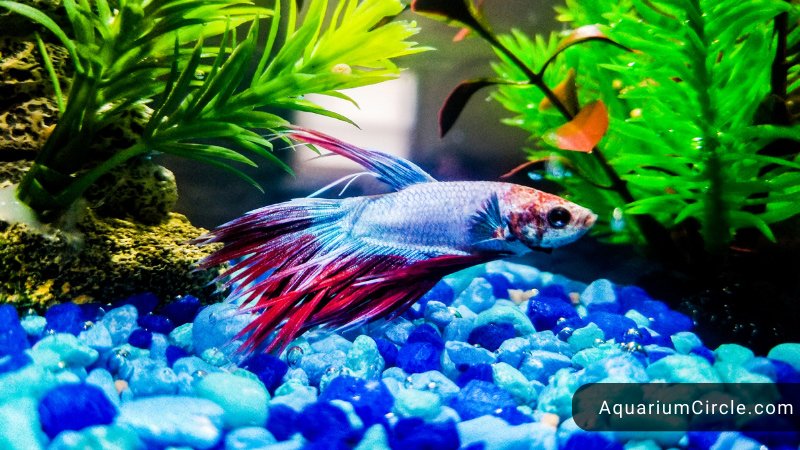
Setting up and placing the aquarium
Proper preparation and placement of your Betta fish tank is essential to ensure your fish’s health and safety. Here are some recommended steps to follow:
First, clean your aquarium with water, but avoid using soap or cleaning agents that could harm your fish. It’s also essential to choose a suitable location for the tank. Placing the tank near a window can provide natural light, but direct sunlight should be avoided as it can be harmful to your Betta fish. LED lights with timers can be used to ensure your fish receives appropriate lighting throughout the day.
When choosing a surface to place the tank, it’s crucial to ensure that it’s sturdy and capable of holding the tank’s weight. A special stand designed to hold an aquarium’s weight is recommended. If you have other pets, it’s best to place the tank in a location that they cannot access, such as a separate room.
When placing the empty fish tank on a surface, leave five inches of space between the wall and the tank to ensure there’s enough room for the tank’s filter.
Put in your filter
After selecting the perfect location for your fish tank, refer to the instruction manual provided by your filter manufacturer. The manual should provide guidance on how to mount and install your specific tank filter. If you need additional help, you can consult with your supplier or search for tutorials on the internet, such as on YouTube.
It’s crucial to remember not to turn on your filter until after your tank is filled with water and all components are in place. This ensures that the filter functions properly and efficiently.
Insert your gravel
Choose a suitable gravel for your tank, avoiding any with large rocks. Before adding the gravel to the tank, rinse it thoroughly under cool running tap water to remove any dust or debris that could dirty the tank or clog the filters. Avoid using soap or cleaning agents that could be harmful to your fish.
If you plan to add live plants to your aquarium, add a layer of gravel that is about two inches deep. For fake silk plants, one inch of gravel is sufficient.
Arrange your plants and decorations
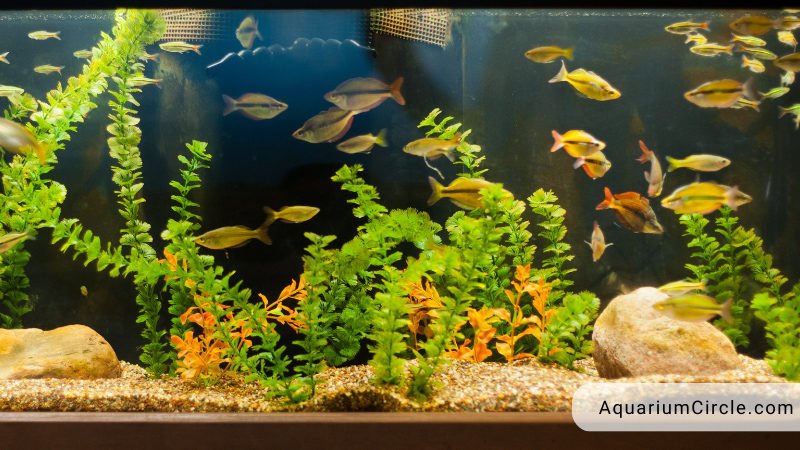
This is the exciting stage, because you get to choose the plants (real or fake) and decorations to put in your tank. Allow your imagination to roam free! If you want to be able to see your Betta fish, place higher plants towards the back so they don’t block your vision.
You simply need to ensure that the decorations are securely secured in the gravel and that the roots of your plants are buried.
Fill the tank with water
Filling your Betta fish tank with water is a crucial step in setting up your fish’s new home. Here are some recommended steps to follow:
- Treat the water: Before filling your tank with water, it’s essential to treat the water with a water conditioner to remove any harmful chemicals, such as chlorine and chloramines. Follow the instructions provided by the water conditioner manufacturer for the recommended dosage.
- Fill the tank: Once the water is treated, begin filling the tank with water. Add water slowly to avoid disturbing the gravel or decorations. Ensure the water level is appropriate for your fish’s size and the tank’s capacity. Avoid overfilling the tank, as this can cause water to overflow.
- Allow the water to settle: After filling the tank with water, allow it to sit for a few hours to let the water settle and reach room temperature. This also allows the filter to cycle and start the biological process that helps keep the water clean.
- Test the water: Once the water has settled, test it with an aquarium water testing kit to ensure that the water is at appropriate levels for your fish’s health. Test for pH, ammonia, nitrite, and nitrate levels to ensure they are within the recommended range.
Install your heater and turn on your filter
You can now turn on the filter and ensure that the water is correctly circulating. You may need to experiment with several settings until you find the ones that work best for you.
The heater, which comes with suction cups to attach to the tank, can then be installed. The water temperature should be between 78 and 80 degrees Fahrenheit. Obtain a thermometer so you can immediately monitor the temperature of the water.
Apply neutralizer and cycle the tank
Finally, if your tank’s water is tap water, you should add a neutralizer to it. The neutralizer will eliminate the chlorine from the water, allowing you to run a fishless cycle.
If you don’t, your Betta fish will perish. Hence, in this natural fishless cycle, good bacteria grow and convert ammonia to nitrites, which are subsequently converted to nitrates. The first two are poisonous, whereas the third is not.
Cycling your tank typically takes four to eight weeks, but the wait is well worth it. Following that, you may introduce your fish to the tank.
See also: Betta Fish Natural Habitat: Where Do Betta Fish Come From And How Do They Live In Wild Environment?
Betta Fish Tank Setup Step 3: It’s Time To Introduce Your Betta To Its New Home
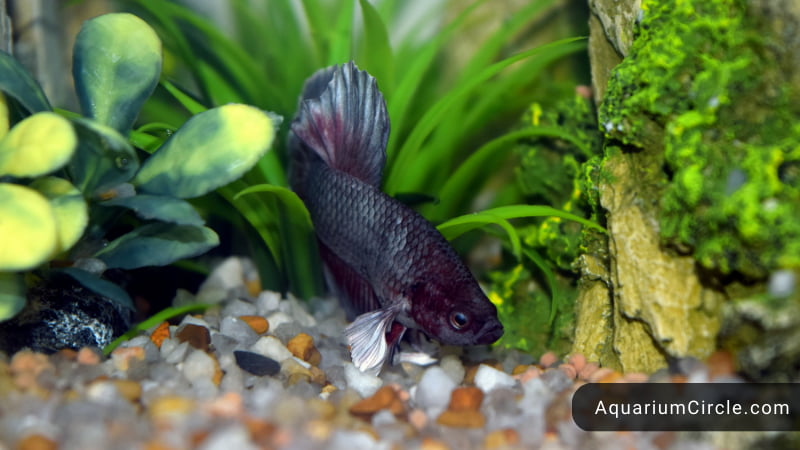
This is the final step in completing your ideal Betta fish tank setup. You can now introduce your fish to their new tank.
So here’s how to do it right in order to keep your Betta fish healthy and happy!
Tips for choosing a healthy Betta
When purchasing a beautiful Betta fish, it is critical that you get a healthy one. You don’t want all of your tank setup efforts to be in vain. Even if the seller assures you that the fish is fine or in good condition, there are a few factors you should look into.
Here are some recommended tips to follow:
- Look for active fish: Healthy Betta fish are active and swim around their tanks, while unhealthy fish may be lethargic and inactive.
- Check for clear eyes: A healthy Betta fish should have clear and bright eyes without any cloudiness or discoloration.
- Examine the fins: Betta fish have delicate and flowing fins, and healthy fish should have unfrayed, undamaged fins. Avoid fish with torn, ragged, or discolored fins.
- Check for healthy skin: A healthy Betta fish should have smooth, unblemished skin without any discoloration or signs of irritation.
- Check for bloating: A healthy Betta fish should have a streamlined and slender body, while an unhealthy fish may appear bloated or swollen.
- Observe the behavior: Watch the Betta fish for a few minutes to observe its behavior. Healthy fish are active and alert, while unhealthy fish may appear listless or disinterested.
- Buy from a reputable source: Purchasing a Betta fish from a reputable source, such as a local fish store, ensures that the fish has been properly cared for and is less likely to have health issues.
See also: Healthy Betta Fish Vs Unhealthy: 9 Signs You Must Notice Before Your Pet Dies
Proper acclimation process
Proper acclimation is an essential process when introducing new fish to a Betta fish tank. The acclimation process helps the fish adjust to the new tank’s environment, reducing the risk of stress, disease, and death.
Before introducing the new fish to the tank, it’s recommended to float the bag containing the fish in the Betta fish tank for about 15-20 minutes. This allows the temperature in the bag to adjust to the tank’s temperature slowly.
After floating the bag, open the bag and add a small amount of water from the tank into the bag. Repeat this process every five minutes until the bag is full. This process helps the fish adjust to the new water conditions gradually.
It’s crucial to check the water quality in the bag using an aquarium test kit. If the water quality is significantly different from the tank’s water quality, repeat the acclimation process until the water parameters in the bag match the tank’s water parameters.
After the acclimation process is complete, release the fish into the Betta fish tank. It’s recommended to avoid adding the water from the bag into the tank as it may contain harmful bacteria or parasites.
Introducing the Betta to the tank
Introducing a new Betta fish to its new tank is an exciting moment, but it’s essential to do it carefully to ensure the fish’s health and safety. The following steps can help make the introduction process successful:
Before introducing the new Betta fish to the tank, turn off the lights. This helps reduce stress and allows the fish to adjust to its new environment slowly.
Float the fish in the bag it came in the tank for about 10-15 minutes. This helps the fish acclimate to the new water temperature and reduce stress.
After the fish has floated in the bag for 10-15 minutes, release the fish gently into the tank. Avoid dumping the fish and water from the bag into the tank, as it can cause the water quality to deteriorate.
Observe the fish for the first few hours to ensure it’s adapting well to its new environment. Avoid feeding the fish for the first 24 hours, as it can take some time for the fish to acclimate to its new surroundings.
Check the water quality regularly in the first few weeks to ensure that it’s stable and healthy for the fish. Test for pH, ammonia, nitrite, and nitrate levels to ensure they are within the recommended range.
By following these steps, you can ensure that the new Betta fish is introduced to its new home safely and comfortably. Proper introduction helps reduce stress, prevent disease, and increase the fish’s chances of thriving in its new environment.
Remember To Maintain Your Betta Tank!
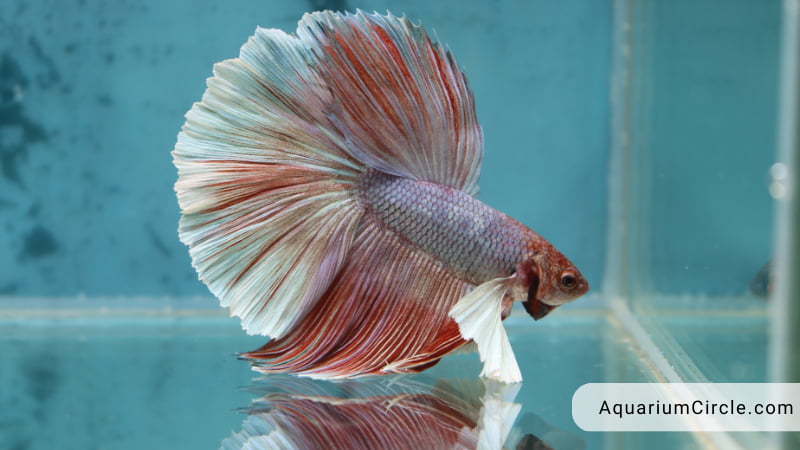
Maintaining a Betta fish tank is crucial to ensure the health and well-being of your fish. Here are some essential tips for maintaining a Betta fish tank:
- Regular water changes: Betta fish require clean water to thrive. It’s recommended to do a 25-30% water change every week to keep the tank clean and healthy for the fish. You can use a siphon to remove debris and uneaten food from the gravel.
- Monitor water parameters: Check the water quality regularly using an aquarium test kit to ensure that the pH, ammonia, nitrite, and nitrate levels are within the recommended range. If you notice any changes in water parameters, take corrective action immediately to prevent stress and disease in your fish.
- Clean the filter: The filter is an essential component of a Betta fish tank. It helps remove waste and debris from the water. It’s recommended to clean the filter every month to ensure it’s functioning correctly.
- Replace filter media: Over time, the filter media can become clogged with debris and lose its effectiveness. It’s recommended to replace the filter media every three to six months, depending on the tank’s size and the number of fish.
- Maintain proper temperature: Betta fish thrive in water temperatures between 76-82 degrees Fahrenheit. It’s recommended to use a heater to maintain a consistent water temperature.
- Feed the fish appropriately: Betta fish require a balanced diet to stay healthy. Feed the fish appropriate amounts of high-quality Betta fish food, and avoid overfeeding to prevent waste buildup in the tank.
By following these tips, you can ensure that your Betta fish tank remains clean and healthy for your fish. A well-maintained tank reduces stress and disease in your fish and helps them thrive in their environment.
See also: How To Tell If Your Betta Fish Is Happy? 6 Important Signs To Look For A Happy Betta Fish
Video About Betta Fish Tank Setup
Final Thoughts
Setting up a betta fish tank can seem overwhelming at first, but it’s essential for the health and well-being of your fish. By choosing the right tank size, equipment, decorations, and plants, you can provide a comfortable and stimulating environment for your betta fish. It’s also important to regularly maintain the tank, including water changes, monitoring water parameters, and cleaning the tank. With proper care, your betta fish can live a long and happy life in its new home. We hope this guide has been helpful in setting up your betta fish tank, and we encourage you to continue learning about betta fish care to provide the best possible life for your finned friend.
FAQs
How big should a Betta fish tank be?
Betta fish should be kept in a minimum of a 5-gallon tank, although larger is always better.
Do Betta fish need a filter?
Yes, betta fish need a filter to maintain water quality and keep the tank clean.
What temperature should a Betta fish tank be?
The temperature should be kept between 76-82°F (24-28°C) for optimal health.
Can Betta fish live with other fish?
It depends on the species of fish and the size of the tank. Bettas are generally solitary fish and may become aggressive towards other fish, so it’s recommended to keep them alone or with non-aggressive tank mates in a larger tank.
Can Betta fish live in a bowl?
No, betta fish should not be kept in a bowl as they need a proper filtration system and room to swim. A bowl also does not provide enough space for necessary decorations, plants, and hiding spots.
References

Annette M. Chaney is an experienced marine biologist with over 20 years of experience as an aquarist and fishkeeper. She started her first aquarium at a young age, filling it with frogs and goldfish obtained from the ten-cent pet store.
Annette grew up caring for and breeding African Cichlids, which led to a hobby in high school that doubled as a profitable means. Attending Reed College gave her time to solidify herself as an accomplished aquarium caretaker with an eye for sales. After that, from 2009 – 2013, she studied at Roger Williams University – one of the most prestigious universities for Aquaculture and Aquarium in USA. She is the founder of AquariumCircle since 2010.
